Teaching, Learning and Assessment in Education and Training
VerifiedAdded on 2023/01/12
|10
|3751
|61
AI Summary
This document discusses the role and responsibilities of teachers in education and training, the relationship between teaching and other professional roles, the importance of identifying and meeting individual learner needs, ways to promote behavior and respect for others, and the purpose and types of assessment used in education and training.
Contribute Materials
Your contribution can guide someone’s learning journey. Share your
documents today.
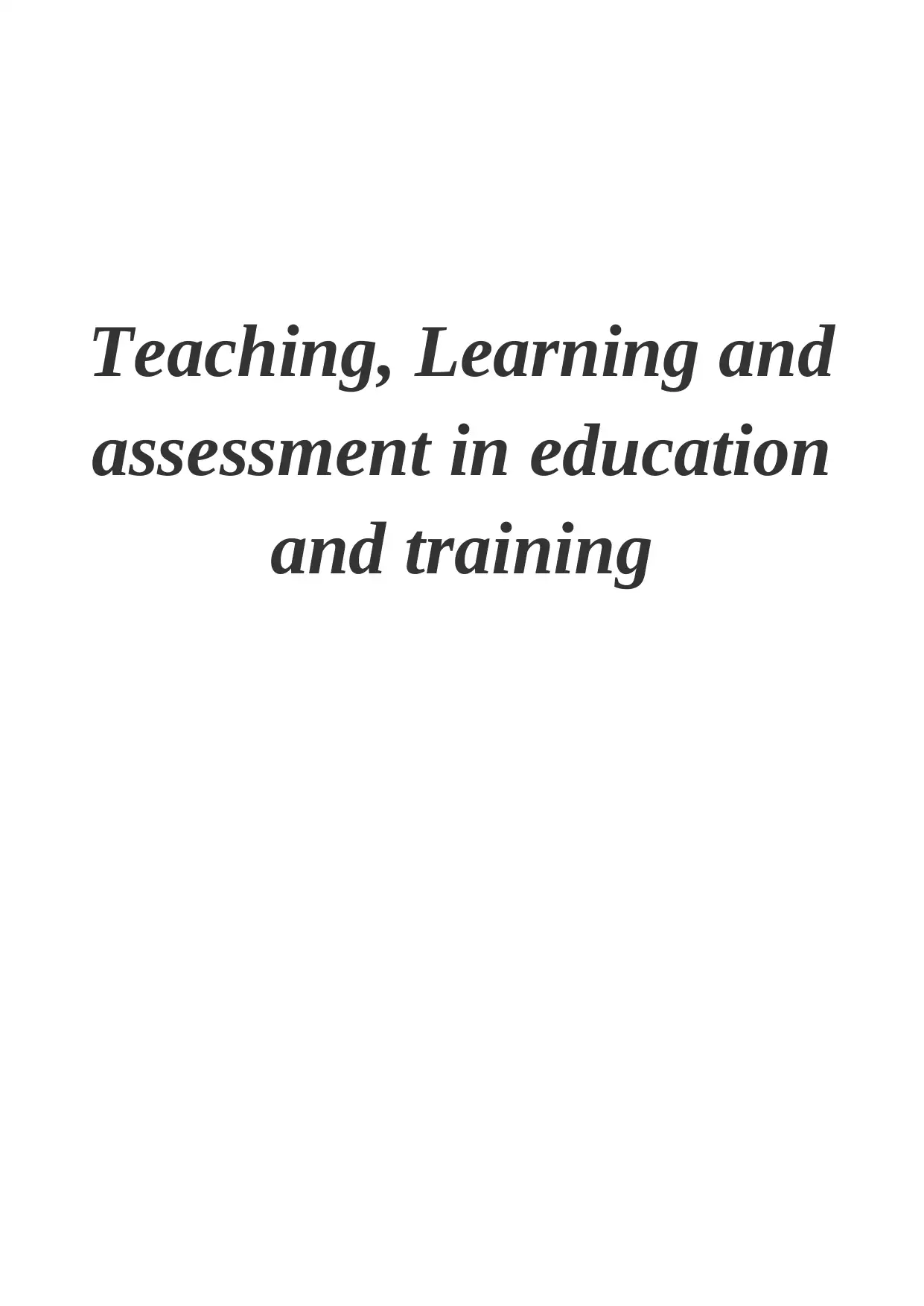
Teaching, Learning and
assessment in education
and training
assessment in education
and training
Secure Best Marks with AI Grader
Need help grading? Try our AI Grader for instant feedback on your assignments.

TASK A...................................................................................................................................................4
a) Own role and responsibilities in education and training...............................................................4
b) Relationship and boundaries between teaching role and other professional role.........................4
c) Role and use of initial and diagnostic assessment in agreeing individual learning goals.............4
TASK B....................................................................................................................................................4
a) Why it is important to identify and meet the individual learner needs.........................................4
b) How own planning meets the individual needs of learners...........................................................4
c) Ways in which teaching and learning plans can be adapted to meet individual need of learners 5
d) Why it is important to promote behaviour and respect for others.................................................5
e) Ways to promote equality and value diversity..............................................................................6
f) Purpose and type of assessment used in education and training...................................................6
TASK D...................................................................................................................................................7
a) Effectiveness of teaching and learning approaches in relation to meet individual needs of
learners.................................................................................................................................................7
b) Benefits and limitation of communication method and media.....................................................7
c) Effectiveness of resources and assessment methods for meeting individual learner needs..........8
d) Ways in which minimum core elements can be demonstrated in planning, delivering and
assessing inclusive teaching and learning............................................................................................8
TASK E....................................................................................................................................................9
a) Review effectiveness of own practice in planning, delivering and assessing inclusive teaching
and learning..........................................................................................................................................9
b) Area of improvement in own practice in planning, delivering and assessing inclusive teaching
and learning..........................................................................................................................................9
a) Own role and responsibilities in education and training...............................................................4
b) Relationship and boundaries between teaching role and other professional role.........................4
c) Role and use of initial and diagnostic assessment in agreeing individual learning goals.............4
TASK B....................................................................................................................................................4
a) Why it is important to identify and meet the individual learner needs.........................................4
b) How own planning meets the individual needs of learners...........................................................4
c) Ways in which teaching and learning plans can be adapted to meet individual need of learners 5
d) Why it is important to promote behaviour and respect for others.................................................5
e) Ways to promote equality and value diversity..............................................................................6
f) Purpose and type of assessment used in education and training...................................................6
TASK D...................................................................................................................................................7
a) Effectiveness of teaching and learning approaches in relation to meet individual needs of
learners.................................................................................................................................................7
b) Benefits and limitation of communication method and media.....................................................7
c) Effectiveness of resources and assessment methods for meeting individual learner needs..........8
d) Ways in which minimum core elements can be demonstrated in planning, delivering and
assessing inclusive teaching and learning............................................................................................8
TASK E....................................................................................................................................................9
a) Review effectiveness of own practice in planning, delivering and assessing inclusive teaching
and learning..........................................................................................................................................9
b) Area of improvement in own practice in planning, delivering and assessing inclusive teaching
and learning..........................................................................................................................................9
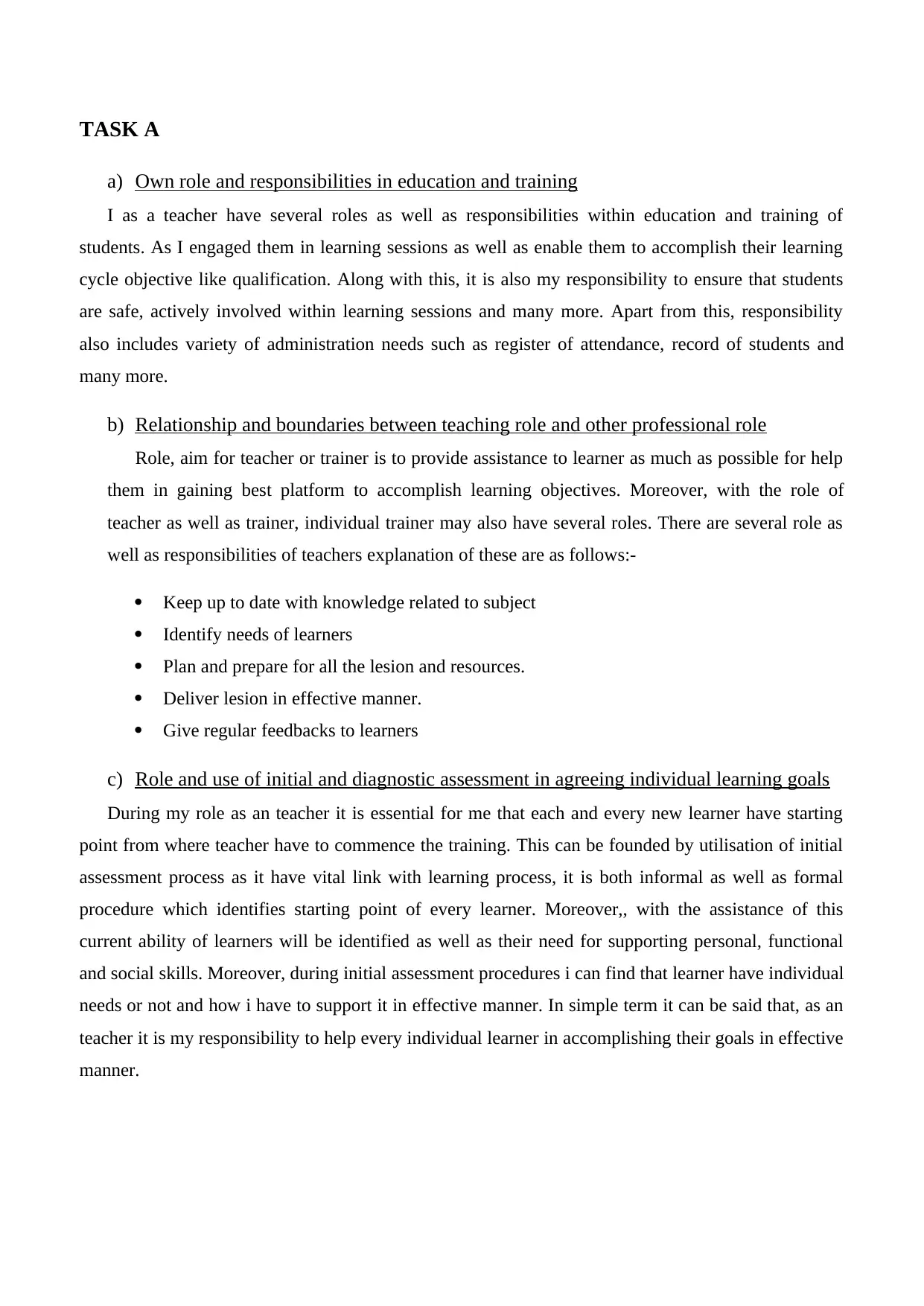
TASK A
a) Own role and responsibilities in education and training
I as a teacher have several roles as well as responsibilities within education and training of
students. As I engaged them in learning sessions as well as enable them to accomplish their learning
cycle objective like qualification. Along with this, it is also my responsibility to ensure that students
are safe, actively involved within learning sessions and many more. Apart from this, responsibility
also includes variety of administration needs such as register of attendance, record of students and
many more.
b) Relationship and boundaries between teaching role and other professional role
Role, aim for teacher or trainer is to provide assistance to learner as much as possible for help
them in gaining best platform to accomplish learning objectives. Moreover, with the role of
teacher as well as trainer, individual trainer may also have several roles. There are several role as
well as responsibilities of teachers explanation of these are as follows:-
Keep up to date with knowledge related to subject
Identify needs of learners
Plan and prepare for all the lesion and resources.
Deliver lesion in effective manner.
Give regular feedbacks to learners
c) Role and use of initial and diagnostic assessment in agreeing individual learning goals
During my role as an teacher it is essential for me that each and every new learner have starting
point from where teacher have to commence the training. This can be founded by utilisation of initial
assessment process as it have vital link with learning process, it is both informal as well as formal
procedure which identifies starting point of every learner. Moreover,, with the assistance of this
current ability of learners will be identified as well as their need for supporting personal, functional
and social skills. Moreover, during initial assessment procedures i can find that learner have individual
needs or not and how i have to support it in effective manner. In simple term it can be said that, as an
teacher it is my responsibility to help every individual learner in accomplishing their goals in effective
manner.
a) Own role and responsibilities in education and training
I as a teacher have several roles as well as responsibilities within education and training of
students. As I engaged them in learning sessions as well as enable them to accomplish their learning
cycle objective like qualification. Along with this, it is also my responsibility to ensure that students
are safe, actively involved within learning sessions and many more. Apart from this, responsibility
also includes variety of administration needs such as register of attendance, record of students and
many more.
b) Relationship and boundaries between teaching role and other professional role
Role, aim for teacher or trainer is to provide assistance to learner as much as possible for help
them in gaining best platform to accomplish learning objectives. Moreover, with the role of
teacher as well as trainer, individual trainer may also have several roles. There are several role as
well as responsibilities of teachers explanation of these are as follows:-
Keep up to date with knowledge related to subject
Identify needs of learners
Plan and prepare for all the lesion and resources.
Deliver lesion in effective manner.
Give regular feedbacks to learners
c) Role and use of initial and diagnostic assessment in agreeing individual learning goals
During my role as an teacher it is essential for me that each and every new learner have starting
point from where teacher have to commence the training. This can be founded by utilisation of initial
assessment process as it have vital link with learning process, it is both informal as well as formal
procedure which identifies starting point of every learner. Moreover,, with the assistance of this
current ability of learners will be identified as well as their need for supporting personal, functional
and social skills. Moreover, during initial assessment procedures i can find that learner have individual
needs or not and how i have to support it in effective manner. In simple term it can be said that, as an
teacher it is my responsibility to help every individual learner in accomplishing their goals in effective
manner.
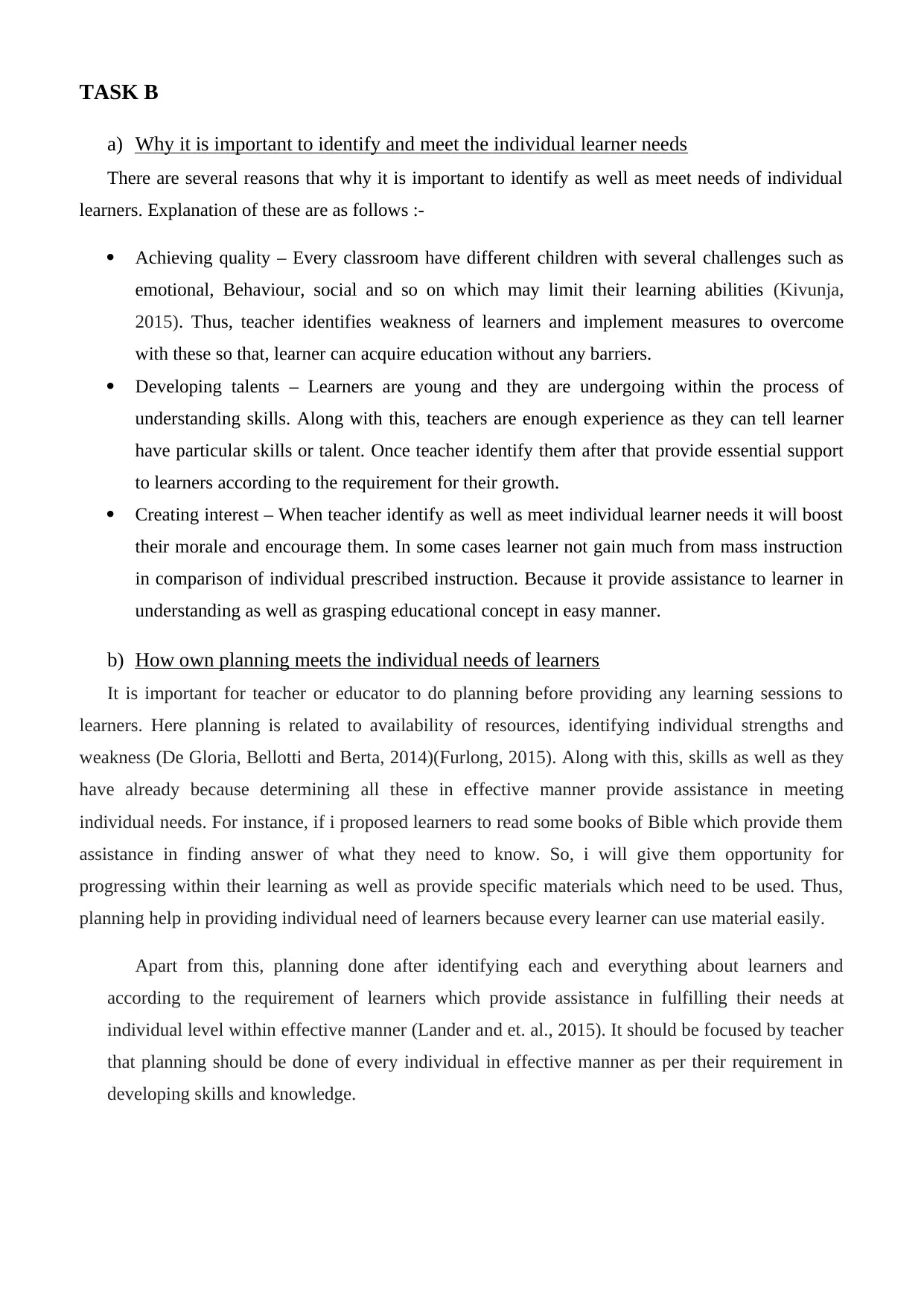
TASK B
a) Why it is important to identify and meet the individual learner needs
There are several reasons that why it is important to identify as well as meet needs of individual
learners. Explanation of these are as follows :-
Achieving quality – Every classroom have different children with several challenges such as
emotional, Behaviour, social and so on which may limit their learning abilities (Kivunja,
2015). Thus, teacher identifies weakness of learners and implement measures to overcome
with these so that, learner can acquire education without any barriers.
Developing talents – Learners are young and they are undergoing within the process of
understanding skills. Along with this, teachers are enough experience as they can tell learner
have particular skills or talent. Once teacher identify them after that provide essential support
to learners according to the requirement for their growth.
Creating interest – When teacher identify as well as meet individual learner needs it will boost
their morale and encourage them. In some cases learner not gain much from mass instruction
in comparison of individual prescribed instruction. Because it provide assistance to learner in
understanding as well as grasping educational concept in easy manner.
b) How own planning meets the individual needs of learners
It is important for teacher or educator to do planning before providing any learning sessions to
learners. Here planning is related to availability of resources, identifying individual strengths and
weakness (De Gloria, Bellotti and Berta, 2014)(Furlong, 2015). Along with this, skills as well as they
have already because determining all these in effective manner provide assistance in meeting
individual needs. For instance, if i proposed learners to read some books of Bible which provide them
assistance in finding answer of what they need to know. So, i will give them opportunity for
progressing within their learning as well as provide specific materials which need to be used. Thus,
planning help in providing individual need of learners because every learner can use material easily.
Apart from this, planning done after identifying each and everything about learners and
according to the requirement of learners which provide assistance in fulfilling their needs at
individual level within effective manner (Lander and et. al., 2015). It should be focused by teacher
that planning should be done of every individual in effective manner as per their requirement in
developing skills and knowledge.
a) Why it is important to identify and meet the individual learner needs
There are several reasons that why it is important to identify as well as meet needs of individual
learners. Explanation of these are as follows :-
Achieving quality – Every classroom have different children with several challenges such as
emotional, Behaviour, social and so on which may limit their learning abilities (Kivunja,
2015). Thus, teacher identifies weakness of learners and implement measures to overcome
with these so that, learner can acquire education without any barriers.
Developing talents – Learners are young and they are undergoing within the process of
understanding skills. Along with this, teachers are enough experience as they can tell learner
have particular skills or talent. Once teacher identify them after that provide essential support
to learners according to the requirement for their growth.
Creating interest – When teacher identify as well as meet individual learner needs it will boost
their morale and encourage them. In some cases learner not gain much from mass instruction
in comparison of individual prescribed instruction. Because it provide assistance to learner in
understanding as well as grasping educational concept in easy manner.
b) How own planning meets the individual needs of learners
It is important for teacher or educator to do planning before providing any learning sessions to
learners. Here planning is related to availability of resources, identifying individual strengths and
weakness (De Gloria, Bellotti and Berta, 2014)(Furlong, 2015). Along with this, skills as well as they
have already because determining all these in effective manner provide assistance in meeting
individual needs. For instance, if i proposed learners to read some books of Bible which provide them
assistance in finding answer of what they need to know. So, i will give them opportunity for
progressing within their learning as well as provide specific materials which need to be used. Thus,
planning help in providing individual need of learners because every learner can use material easily.
Apart from this, planning done after identifying each and everything about learners and
according to the requirement of learners which provide assistance in fulfilling their needs at
individual level within effective manner (Lander and et. al., 2015). It should be focused by teacher
that planning should be done of every individual in effective manner as per their requirement in
developing skills and knowledge.
Secure Best Marks with AI Grader
Need help grading? Try our AI Grader for instant feedback on your assignments.
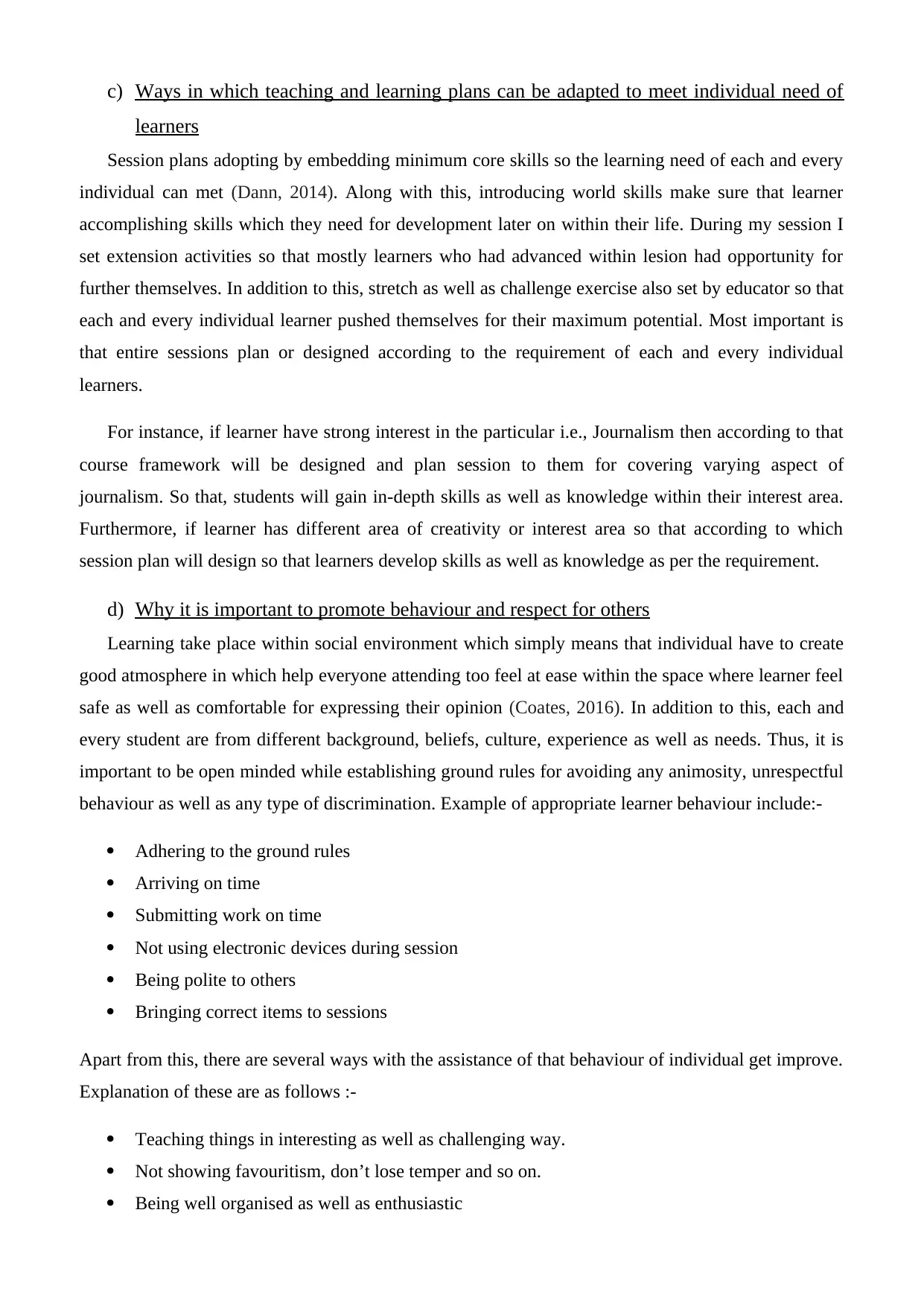
c) Ways in which teaching and learning plans can be adapted to meet individual need of
learners
Session plans adopting by embedding minimum core skills so the learning need of each and every
individual can met (Dann, 2014). Along with this, introducing world skills make sure that learner
accomplishing skills which they need for development later on within their life. During my session I
set extension activities so that mostly learners who had advanced within lesion had opportunity for
further themselves. In addition to this, stretch as well as challenge exercise also set by educator so that
each and every individual learner pushed themselves for their maximum potential. Most important is
that entire sessions plan or designed according to the requirement of each and every individual
learners.
For instance, if learner have strong interest in the particular i.e., Journalism then according to that
course framework will be designed and plan session to them for covering varying aspect of
journalism. So that, students will gain in-depth skills as well as knowledge within their interest area.
Furthermore, if learner has different area of creativity or interest area so that according to which
session plan will design so that learners develop skills as well as knowledge as per the requirement.
d) Why it is important to promote behaviour and respect for others
Learning take place within social environment which simply means that individual have to create
good atmosphere in which help everyone attending too feel at ease within the space where learner feel
safe as well as comfortable for expressing their opinion (Coates, 2016). In addition to this, each and
every student are from different background, beliefs, culture, experience as well as needs. Thus, it is
important to be open minded while establishing ground rules for avoiding any animosity, unrespectful
behaviour as well as any type of discrimination. Example of appropriate learner behaviour include:-
Adhering to the ground rules
Arriving on time
Submitting work on time
Not using electronic devices during session
Being polite to others
Bringing correct items to sessions
Apart from this, there are several ways with the assistance of that behaviour of individual get improve.
Explanation of these are as follows :-
Teaching things in interesting as well as challenging way.
Not showing favouritism, don’t lose temper and so on.
Being well organised as well as enthusiastic
learners
Session plans adopting by embedding minimum core skills so the learning need of each and every
individual can met (Dann, 2014). Along with this, introducing world skills make sure that learner
accomplishing skills which they need for development later on within their life. During my session I
set extension activities so that mostly learners who had advanced within lesion had opportunity for
further themselves. In addition to this, stretch as well as challenge exercise also set by educator so that
each and every individual learner pushed themselves for their maximum potential. Most important is
that entire sessions plan or designed according to the requirement of each and every individual
learners.
For instance, if learner have strong interest in the particular i.e., Journalism then according to that
course framework will be designed and plan session to them for covering varying aspect of
journalism. So that, students will gain in-depth skills as well as knowledge within their interest area.
Furthermore, if learner has different area of creativity or interest area so that according to which
session plan will design so that learners develop skills as well as knowledge as per the requirement.
d) Why it is important to promote behaviour and respect for others
Learning take place within social environment which simply means that individual have to create
good atmosphere in which help everyone attending too feel at ease within the space where learner feel
safe as well as comfortable for expressing their opinion (Coates, 2016). In addition to this, each and
every student are from different background, beliefs, culture, experience as well as needs. Thus, it is
important to be open minded while establishing ground rules for avoiding any animosity, unrespectful
behaviour as well as any type of discrimination. Example of appropriate learner behaviour include:-
Adhering to the ground rules
Arriving on time
Submitting work on time
Not using electronic devices during session
Being polite to others
Bringing correct items to sessions
Apart from this, there are several ways with the assistance of that behaviour of individual get improve.
Explanation of these are as follows :-
Teaching things in interesting as well as challenging way.
Not showing favouritism, don’t lose temper and so on.
Being well organised as well as enthusiastic
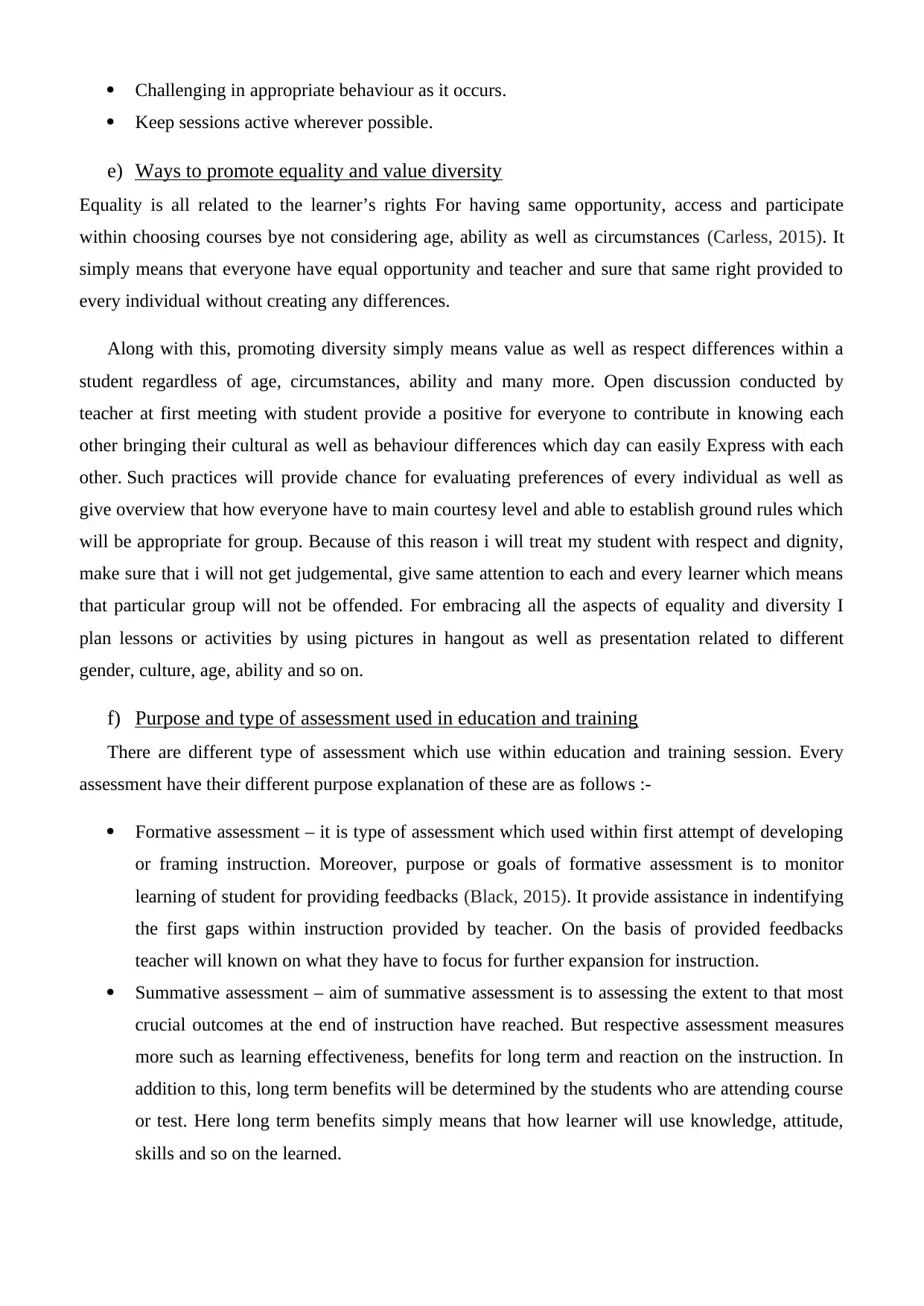
Challenging in appropriate behaviour as it occurs.
Keep sessions active wherever possible.
e) Ways to promote equality and value diversity
Equality is all related to the learner’s rights For having same opportunity, access and participate
within choosing courses bye not considering age, ability as well as circumstances (Carless, 2015). It
simply means that everyone have equal opportunity and teacher and sure that same right provided to
every individual without creating any differences.
Along with this, promoting diversity simply means value as well as respect differences within a
student regardless of age, circumstances, ability and many more. Open discussion conducted by
teacher at first meeting with student provide a positive for everyone to contribute in knowing each
other bringing their cultural as well as behaviour differences which day can easily Express with each
other. Such practices will provide chance for evaluating preferences of every individual as well as
give overview that how everyone have to main courtesy level and able to establish ground rules which
will be appropriate for group. Because of this reason i will treat my student with respect and dignity,
make sure that i will not get judgemental, give same attention to each and every learner which means
that particular group will not be offended. For embracing all the aspects of equality and diversity I
plan lessons or activities by using pictures in hangout as well as presentation related to different
gender, culture, age, ability and so on.
f) Purpose and type of assessment used in education and training
There are different type of assessment which use within education and training session. Every
assessment have their different purpose explanation of these are as follows :-
Formative assessment – it is type of assessment which used within first attempt of developing
or framing instruction. Moreover, purpose or goals of formative assessment is to monitor
learning of student for providing feedbacks (Black, 2015). It provide assistance in indentifying
the first gaps within instruction provided by teacher. On the basis of provided feedbacks
teacher will known on what they have to focus for further expansion for instruction.
Summative assessment – aim of summative assessment is to assessing the extent to that most
crucial outcomes at the end of instruction have reached. But respective assessment measures
more such as learning effectiveness, benefits for long term and reaction on the instruction. In
addition to this, long term benefits will be determined by the students who are attending course
or test. Here long term benefits simply means that how learner will use knowledge, attitude,
skills and so on the learned.
Keep sessions active wherever possible.
e) Ways to promote equality and value diversity
Equality is all related to the learner’s rights For having same opportunity, access and participate
within choosing courses bye not considering age, ability as well as circumstances (Carless, 2015). It
simply means that everyone have equal opportunity and teacher and sure that same right provided to
every individual without creating any differences.
Along with this, promoting diversity simply means value as well as respect differences within a
student regardless of age, circumstances, ability and many more. Open discussion conducted by
teacher at first meeting with student provide a positive for everyone to contribute in knowing each
other bringing their cultural as well as behaviour differences which day can easily Express with each
other. Such practices will provide chance for evaluating preferences of every individual as well as
give overview that how everyone have to main courtesy level and able to establish ground rules which
will be appropriate for group. Because of this reason i will treat my student with respect and dignity,
make sure that i will not get judgemental, give same attention to each and every learner which means
that particular group will not be offended. For embracing all the aspects of equality and diversity I
plan lessons or activities by using pictures in hangout as well as presentation related to different
gender, culture, age, ability and so on.
f) Purpose and type of assessment used in education and training
There are different type of assessment which use within education and training session. Every
assessment have their different purpose explanation of these are as follows :-
Formative assessment – it is type of assessment which used within first attempt of developing
or framing instruction. Moreover, purpose or goals of formative assessment is to monitor
learning of student for providing feedbacks (Black, 2015). It provide assistance in indentifying
the first gaps within instruction provided by teacher. On the basis of provided feedbacks
teacher will known on what they have to focus for further expansion for instruction.
Summative assessment – aim of summative assessment is to assessing the extent to that most
crucial outcomes at the end of instruction have reached. But respective assessment measures
more such as learning effectiveness, benefits for long term and reaction on the instruction. In
addition to this, long term benefits will be determined by the students who are attending course
or test. Here long term benefits simply means that how learner will use knowledge, attitude,
skills and so on the learned.
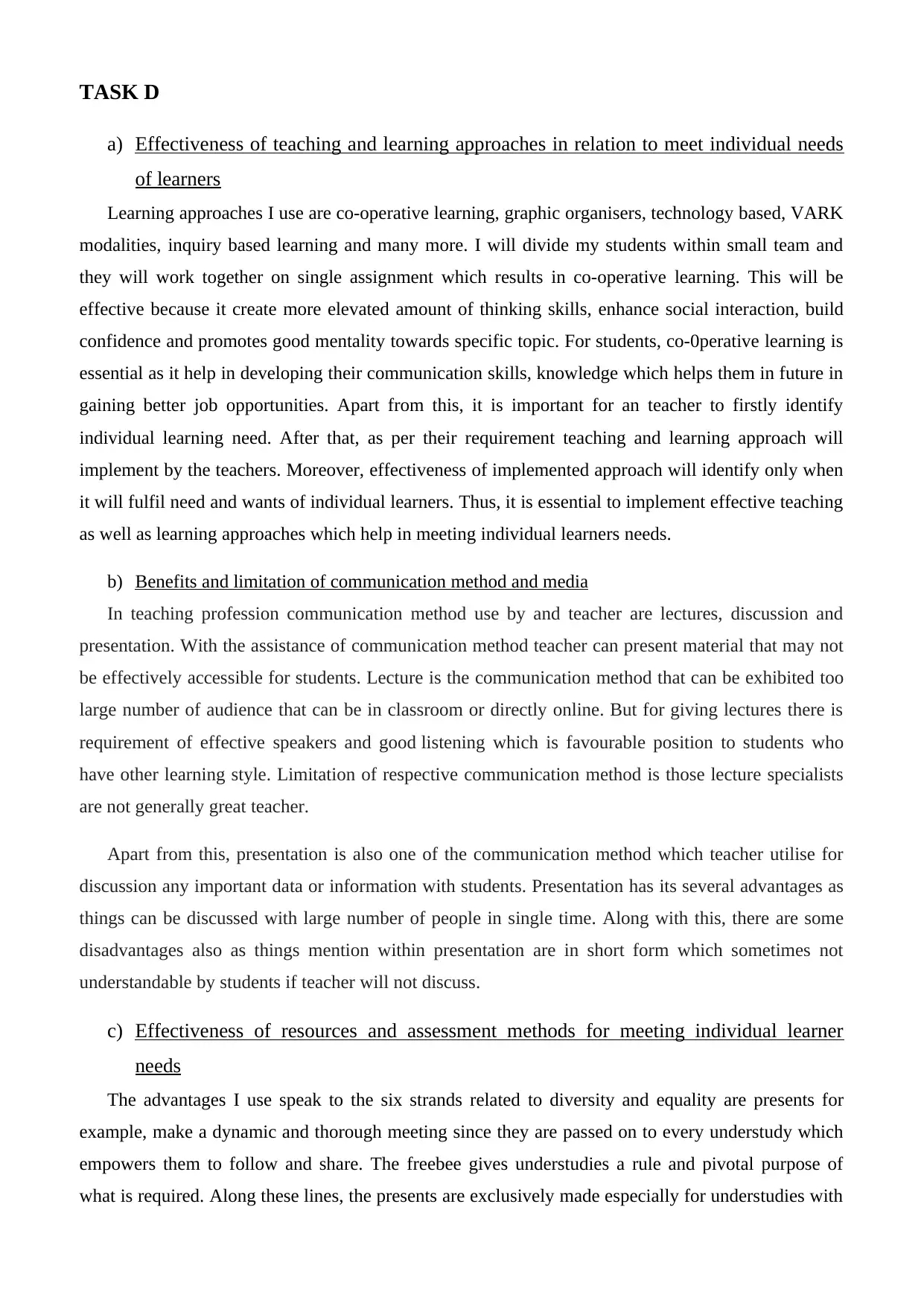
TASK D
a) Effectiveness of teaching and learning approaches in relation to meet individual needs
of learners
Learning approaches I use are co-operative learning, graphic organisers, technology based, VARK
modalities, inquiry based learning and many more. I will divide my students within small team and
they will work together on single assignment which results in co-operative learning. This will be
effective because it create more elevated amount of thinking skills, enhance social interaction, build
confidence and promotes good mentality towards specific topic. For students, co-0perative learning is
essential as it help in developing their communication skills, knowledge which helps them in future in
gaining better job opportunities. Apart from this, it is important for an teacher to firstly identify
individual learning need. After that, as per their requirement teaching and learning approach will
implement by the teachers. Moreover, effectiveness of implemented approach will identify only when
it will fulfil need and wants of individual learners. Thus, it is essential to implement effective teaching
as well as learning approaches which help in meeting individual learners needs.
b) Benefits and limitation of communication method and media
In teaching profession communication method use by and teacher are lectures, discussion and
presentation. With the assistance of communication method teacher can present material that may not
be effectively accessible for students. Lecture is the communication method that can be exhibited too
large number of audience that can be in classroom or directly online. But for giving lectures there is
requirement of effective speakers and good listening which is favourable position to students who
have other learning style. Limitation of respective communication method is those lecture specialists
are not generally great teacher.
Apart from this, presentation is also one of the communication method which teacher utilise for
discussion any important data or information with students. Presentation has its several advantages as
things can be discussed with large number of people in single time. Along with this, there are some
disadvantages also as things mention within presentation are in short form which sometimes not
understandable by students if teacher will not discuss.
c) Effectiveness of resources and assessment methods for meeting individual learner
needs
The advantages I use speak to the six strands related to diversity and equality are presents for
example, make a dynamic and thorough meeting since they are passed on to every understudy which
empowers them to follow and share. The freebee gives understudies a rule and pivotal purpose of
what is required. Along these lines, the presents are exclusively made especially for understudies with
a) Effectiveness of teaching and learning approaches in relation to meet individual needs
of learners
Learning approaches I use are co-operative learning, graphic organisers, technology based, VARK
modalities, inquiry based learning and many more. I will divide my students within small team and
they will work together on single assignment which results in co-operative learning. This will be
effective because it create more elevated amount of thinking skills, enhance social interaction, build
confidence and promotes good mentality towards specific topic. For students, co-0perative learning is
essential as it help in developing their communication skills, knowledge which helps them in future in
gaining better job opportunities. Apart from this, it is important for an teacher to firstly identify
individual learning need. After that, as per their requirement teaching and learning approach will
implement by the teachers. Moreover, effectiveness of implemented approach will identify only when
it will fulfil need and wants of individual learners. Thus, it is essential to implement effective teaching
as well as learning approaches which help in meeting individual learners needs.
b) Benefits and limitation of communication method and media
In teaching profession communication method use by and teacher are lectures, discussion and
presentation. With the assistance of communication method teacher can present material that may not
be effectively accessible for students. Lecture is the communication method that can be exhibited too
large number of audience that can be in classroom or directly online. But for giving lectures there is
requirement of effective speakers and good listening which is favourable position to students who
have other learning style. Limitation of respective communication method is those lecture specialists
are not generally great teacher.
Apart from this, presentation is also one of the communication method which teacher utilise for
discussion any important data or information with students. Presentation has its several advantages as
things can be discussed with large number of people in single time. Along with this, there are some
disadvantages also as things mention within presentation are in short form which sometimes not
understandable by students if teacher will not discuss.
c) Effectiveness of resources and assessment methods for meeting individual learner
needs
The advantages I use speak to the six strands related to diversity and equality are presents for
example, make a dynamic and thorough meeting since they are passed on to every understudy which
empowers them to follow and share. The freebee gives understudies a rule and pivotal purpose of
what is required. Along these lines, the presents are exclusively made especially for understudies with
Paraphrase This Document
Need a fresh take? Get an instant paraphrase of this document with our AI Paraphraser
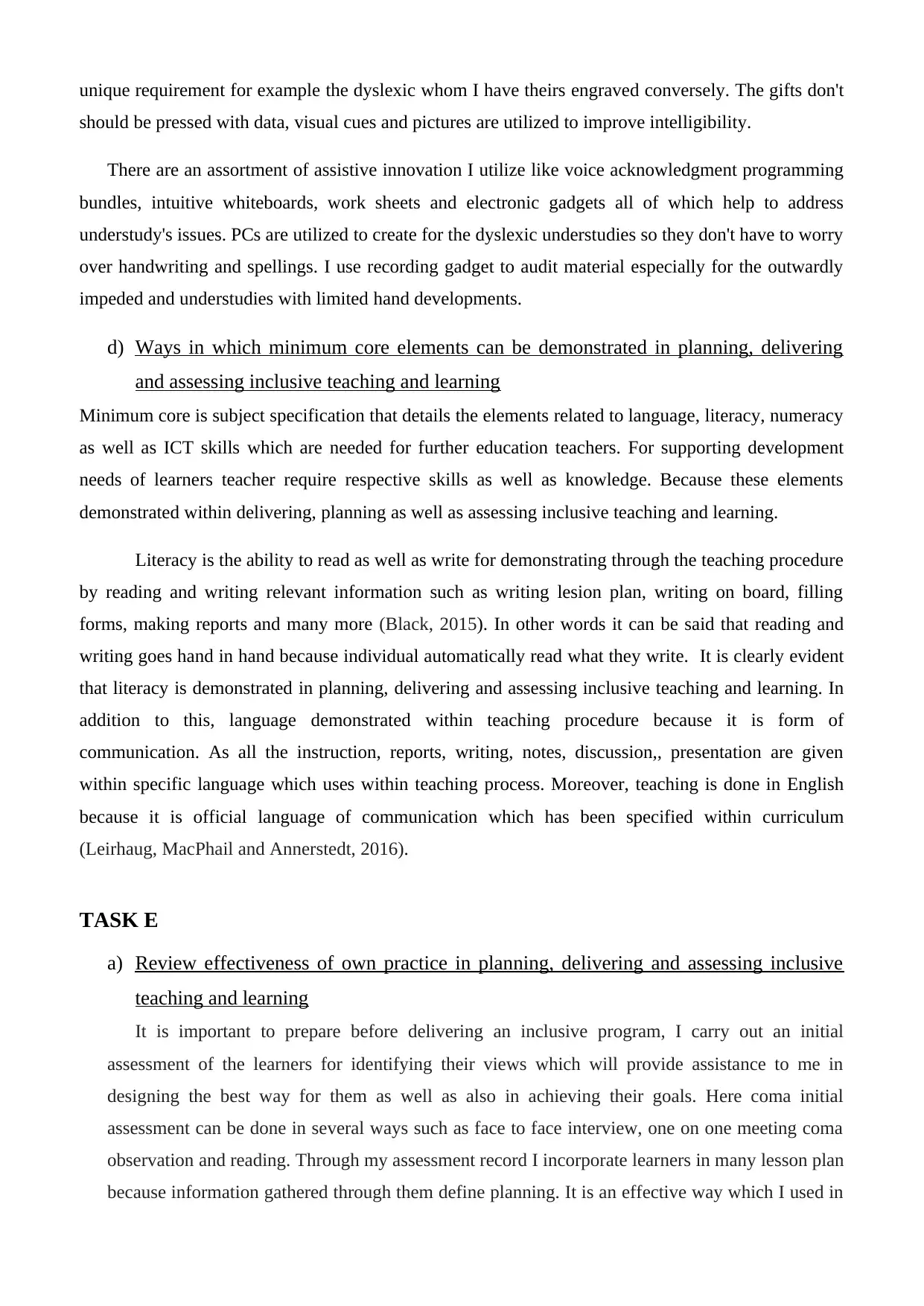
unique requirement for example the dyslexic whom I have theirs engraved conversely. The gifts don't
should be pressed with data, visual cues and pictures are utilized to improve intelligibility.
There are an assortment of assistive innovation I utilize like voice acknowledgment programming
bundles, intuitive whiteboards, work sheets and electronic gadgets all of which help to address
understudy's issues. PCs are utilized to create for the dyslexic understudies so they don't have to worry
over handwriting and spellings. I use recording gadget to audit material especially for the outwardly
impeded and understudies with limited hand developments.
d) Ways in which minimum core elements can be demonstrated in planning, delivering
and assessing inclusive teaching and learning
Minimum core is subject specification that details the elements related to language, literacy, numeracy
as well as ICT skills which are needed for further education teachers. For supporting development
needs of learners teacher require respective skills as well as knowledge. Because these elements
demonstrated within delivering, planning as well as assessing inclusive teaching and learning.
Literacy is the ability to read as well as write for demonstrating through the teaching procedure
by reading and writing relevant information such as writing lesion plan, writing on board, filling
forms, making reports and many more (Black, 2015). In other words it can be said that reading and
writing goes hand in hand because individual automatically read what they write. It is clearly evident
that literacy is demonstrated in planning, delivering and assessing inclusive teaching and learning. In
addition to this, language demonstrated within teaching procedure because it is form of
communication. As all the instruction, reports, writing, notes, discussion,, presentation are given
within specific language which uses within teaching process. Moreover, teaching is done in English
because it is official language of communication which has been specified within curriculum
(Leirhaug, MacPhail and Annerstedt, 2016).
TASK E
a) Review effectiveness of own practice in planning, delivering and assessing inclusive
teaching and learning
It is important to prepare before delivering an inclusive program, I carry out an initial
assessment of the learners for identifying their views which will provide assistance to me in
designing the best way for them as well as also in achieving their goals. Here coma initial
assessment can be done in several ways such as face to face interview, one on one meeting coma
observation and reading. Through my assessment record I incorporate learners in many lesson plan
because information gathered through them define planning. It is an effective way which I used in
should be pressed with data, visual cues and pictures are utilized to improve intelligibility.
There are an assortment of assistive innovation I utilize like voice acknowledgment programming
bundles, intuitive whiteboards, work sheets and electronic gadgets all of which help to address
understudy's issues. PCs are utilized to create for the dyslexic understudies so they don't have to worry
over handwriting and spellings. I use recording gadget to audit material especially for the outwardly
impeded and understudies with limited hand developments.
d) Ways in which minimum core elements can be demonstrated in planning, delivering
and assessing inclusive teaching and learning
Minimum core is subject specification that details the elements related to language, literacy, numeracy
as well as ICT skills which are needed for further education teachers. For supporting development
needs of learners teacher require respective skills as well as knowledge. Because these elements
demonstrated within delivering, planning as well as assessing inclusive teaching and learning.
Literacy is the ability to read as well as write for demonstrating through the teaching procedure
by reading and writing relevant information such as writing lesion plan, writing on board, filling
forms, making reports and many more (Black, 2015). In other words it can be said that reading and
writing goes hand in hand because individual automatically read what they write. It is clearly evident
that literacy is demonstrated in planning, delivering and assessing inclusive teaching and learning. In
addition to this, language demonstrated within teaching procedure because it is form of
communication. As all the instruction, reports, writing, notes, discussion,, presentation are given
within specific language which uses within teaching process. Moreover, teaching is done in English
because it is official language of communication which has been specified within curriculum
(Leirhaug, MacPhail and Annerstedt, 2016).
TASK E
a) Review effectiveness of own practice in planning, delivering and assessing inclusive
teaching and learning
It is important to prepare before delivering an inclusive program, I carry out an initial
assessment of the learners for identifying their views which will provide assistance to me in
designing the best way for them as well as also in achieving their goals. Here coma initial
assessment can be done in several ways such as face to face interview, one on one meeting coma
observation and reading. Through my assessment record I incorporate learners in many lesson plan
because information gathered through them define planning. It is an effective way which I used in
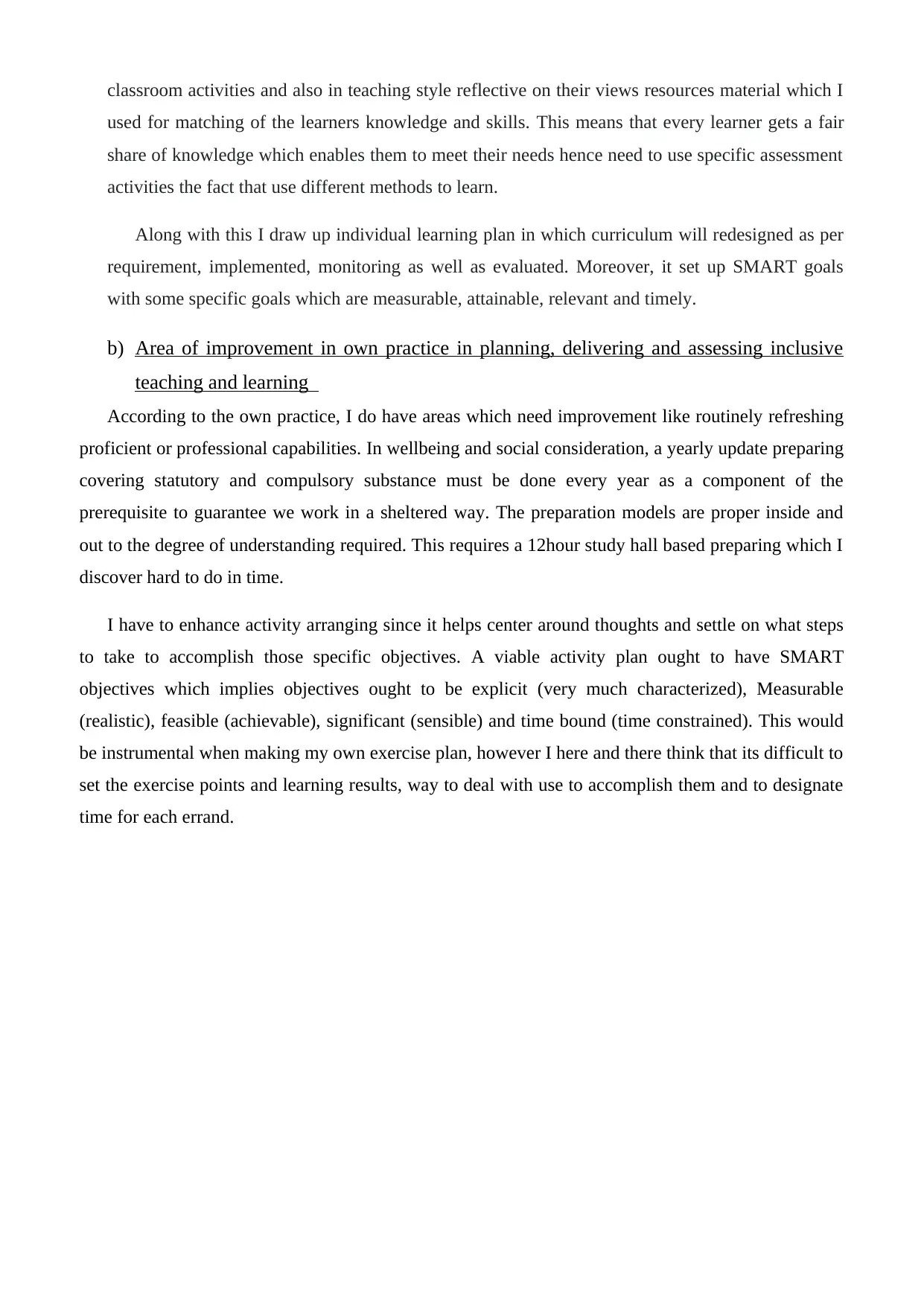
classroom activities and also in teaching style reflective on their views resources material which I
used for matching of the learners knowledge and skills. This means that every learner gets a fair
share of knowledge which enables them to meet their needs hence need to use specific assessment
activities the fact that use different methods to learn.
Along with this I draw up individual learning plan in which curriculum will redesigned as per
requirement, implemented, monitoring as well as evaluated. Moreover, it set up SMART goals
with some specific goals which are measurable, attainable, relevant and timely.
b) Area of improvement in own practice in planning, delivering and assessing inclusive
teaching and learning
According to the own practice, I do have areas which need improvement like routinely refreshing
proficient or professional capabilities. In wellbeing and social consideration, a yearly update preparing
covering statutory and compulsory substance must be done every year as a component of the
prerequisite to guarantee we work in a sheltered way. The preparation models are proper inside and
out to the degree of understanding required. This requires a 12hour study hall based preparing which I
discover hard to do in time.
I have to enhance activity arranging since it helps center around thoughts and settle on what steps
to take to accomplish those specific objectives. A viable activity plan ought to have SMART
objectives which implies objectives ought to be explicit (very much characterized), Measurable
(realistic), feasible (achievable), significant (sensible) and time bound (time constrained). This would
be instrumental when making my own exercise plan, however I here and there think that its difficult to
set the exercise points and learning results, way to deal with use to accomplish them and to designate
time for each errand.
used for matching of the learners knowledge and skills. This means that every learner gets a fair
share of knowledge which enables them to meet their needs hence need to use specific assessment
activities the fact that use different methods to learn.
Along with this I draw up individual learning plan in which curriculum will redesigned as per
requirement, implemented, monitoring as well as evaluated. Moreover, it set up SMART goals
with some specific goals which are measurable, attainable, relevant and timely.
b) Area of improvement in own practice in planning, delivering and assessing inclusive
teaching and learning
According to the own practice, I do have areas which need improvement like routinely refreshing
proficient or professional capabilities. In wellbeing and social consideration, a yearly update preparing
covering statutory and compulsory substance must be done every year as a component of the
prerequisite to guarantee we work in a sheltered way. The preparation models are proper inside and
out to the degree of understanding required. This requires a 12hour study hall based preparing which I
discover hard to do in time.
I have to enhance activity arranging since it helps center around thoughts and settle on what steps
to take to accomplish those specific objectives. A viable activity plan ought to have SMART
objectives which implies objectives ought to be explicit (very much characterized), Measurable
(realistic), feasible (achievable), significant (sensible) and time bound (time constrained). This would
be instrumental when making my own exercise plan, however I here and there think that its difficult to
set the exercise points and learning results, way to deal with use to accomplish them and to designate
time for each errand.
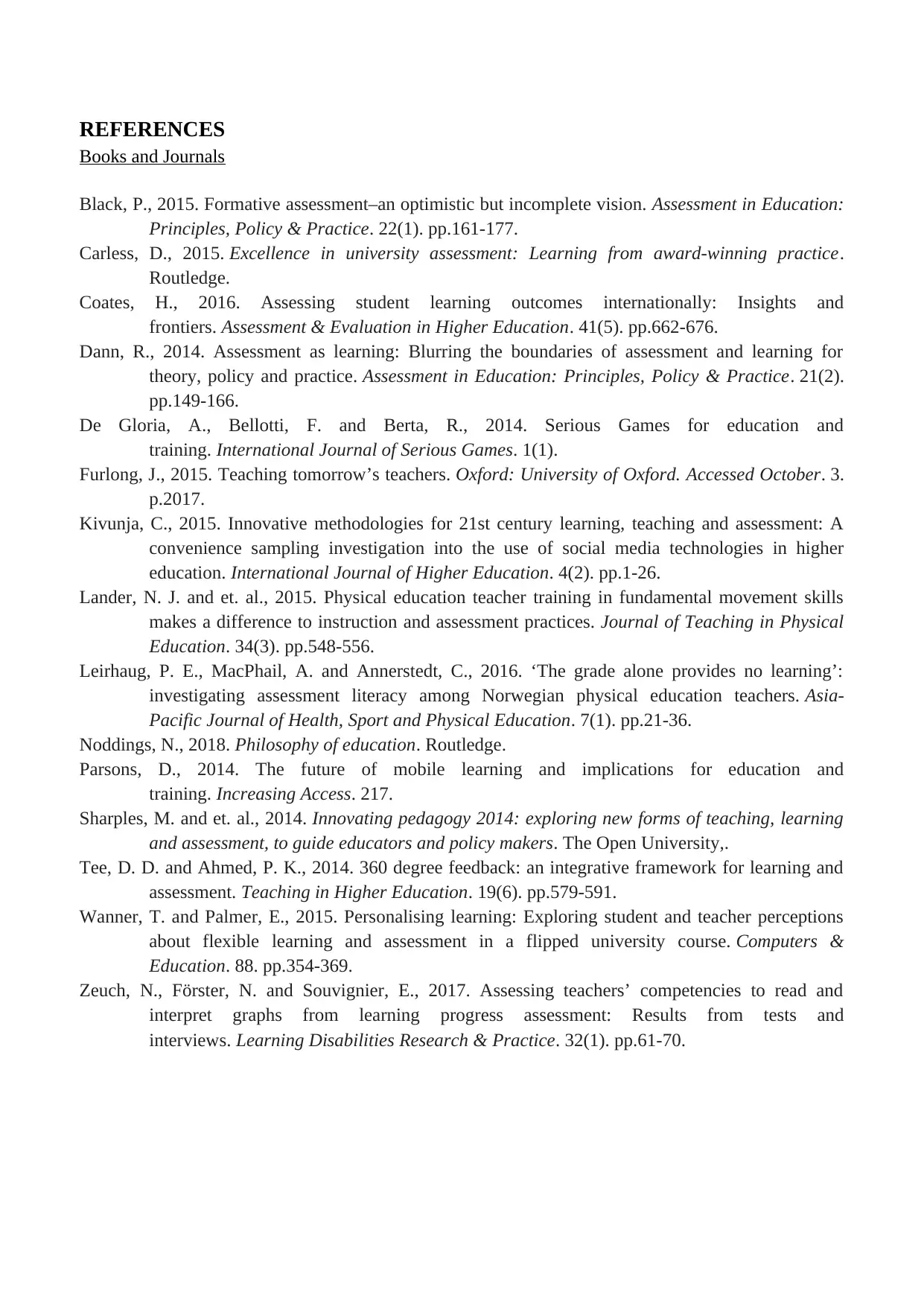
REFERENCES
Books and Journals
Black, P., 2015. Formative assessment–an optimistic but incomplete vision. Assessment in Education:
Principles, Policy & Practice. 22(1). pp.161-177.
Carless, D., 2015. Excellence in university assessment: Learning from award-winning practice.
Routledge.
Coates, H., 2016. Assessing student learning outcomes internationally: Insights and
frontiers. Assessment & Evaluation in Higher Education. 41(5). pp.662-676.
Dann, R., 2014. Assessment as learning: Blurring the boundaries of assessment and learning for
theory, policy and practice. Assessment in Education: Principles, Policy & Practice. 21(2).
pp.149-166.
De Gloria, A., Bellotti, F. and Berta, R., 2014. Serious Games for education and
training. International Journal of Serious Games. 1(1).
Furlong, J., 2015. Teaching tomorrow’s teachers. Oxford: University of Oxford. Accessed October. 3.
p.2017.
Kivunja, C., 2015. Innovative methodologies for 21st century learning, teaching and assessment: A
convenience sampling investigation into the use of social media technologies in higher
education. International Journal of Higher Education. 4(2). pp.1-26.
Lander, N. J. and et. al., 2015. Physical education teacher training in fundamental movement skills
makes a difference to instruction and assessment practices. Journal of Teaching in Physical
Education. 34(3). pp.548-556.
Leirhaug, P. E., MacPhail, A. and Annerstedt, C., 2016. ‘The grade alone provides no learning’:
investigating assessment literacy among Norwegian physical education teachers. Asia-
Pacific Journal of Health, Sport and Physical Education. 7(1). pp.21-36.
Noddings, N., 2018. Philosophy of education. Routledge.
Parsons, D., 2014. The future of mobile learning and implications for education and
training. Increasing Access. 217.
Sharples, M. and et. al., 2014. Innovating pedagogy 2014: exploring new forms of teaching, learning
and assessment, to guide educators and policy makers. The Open University,.
Tee, D. D. and Ahmed, P. K., 2014. 360 degree feedback: an integrative framework for learning and
assessment. Teaching in Higher Education. 19(6). pp.579-591.
Wanner, T. and Palmer, E., 2015. Personalising learning: Exploring student and teacher perceptions
about flexible learning and assessment in a flipped university course. Computers &
Education. 88. pp.354-369.
Zeuch, N., Förster, N. and Souvignier, E., 2017. Assessing teachers’ competencies to read and
interpret graphs from learning progress assessment: Results from tests and
interviews. Learning Disabilities Research & Practice. 32(1). pp.61-70.
Books and Journals
Black, P., 2015. Formative assessment–an optimistic but incomplete vision. Assessment in Education:
Principles, Policy & Practice. 22(1). pp.161-177.
Carless, D., 2015. Excellence in university assessment: Learning from award-winning practice.
Routledge.
Coates, H., 2016. Assessing student learning outcomes internationally: Insights and
frontiers. Assessment & Evaluation in Higher Education. 41(5). pp.662-676.
Dann, R., 2014. Assessment as learning: Blurring the boundaries of assessment and learning for
theory, policy and practice. Assessment in Education: Principles, Policy & Practice. 21(2).
pp.149-166.
De Gloria, A., Bellotti, F. and Berta, R., 2014. Serious Games for education and
training. International Journal of Serious Games. 1(1).
Furlong, J., 2015. Teaching tomorrow’s teachers. Oxford: University of Oxford. Accessed October. 3.
p.2017.
Kivunja, C., 2015. Innovative methodologies for 21st century learning, teaching and assessment: A
convenience sampling investigation into the use of social media technologies in higher
education. International Journal of Higher Education. 4(2). pp.1-26.
Lander, N. J. and et. al., 2015. Physical education teacher training in fundamental movement skills
makes a difference to instruction and assessment practices. Journal of Teaching in Physical
Education. 34(3). pp.548-556.
Leirhaug, P. E., MacPhail, A. and Annerstedt, C., 2016. ‘The grade alone provides no learning’:
investigating assessment literacy among Norwegian physical education teachers. Asia-
Pacific Journal of Health, Sport and Physical Education. 7(1). pp.21-36.
Noddings, N., 2018. Philosophy of education. Routledge.
Parsons, D., 2014. The future of mobile learning and implications for education and
training. Increasing Access. 217.
Sharples, M. and et. al., 2014. Innovating pedagogy 2014: exploring new forms of teaching, learning
and assessment, to guide educators and policy makers. The Open University,.
Tee, D. D. and Ahmed, P. K., 2014. 360 degree feedback: an integrative framework for learning and
assessment. Teaching in Higher Education. 19(6). pp.579-591.
Wanner, T. and Palmer, E., 2015. Personalising learning: Exploring student and teacher perceptions
about flexible learning and assessment in a flipped university course. Computers &
Education. 88. pp.354-369.
Zeuch, N., Förster, N. and Souvignier, E., 2017. Assessing teachers’ competencies to read and
interpret graphs from learning progress assessment: Results from tests and
interviews. Learning Disabilities Research & Practice. 32(1). pp.61-70.
1 out of 10
Related Documents
Your All-in-One AI-Powered Toolkit for Academic Success.
+13062052269
info@desklib.com
Available 24*7 on WhatsApp / Email
![[object Object]](/_next/static/media/star-bottom.7253800d.svg)
Unlock your academic potential
© 2024 | Zucol Services PVT LTD | All rights reserved.


